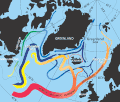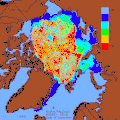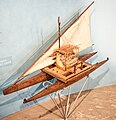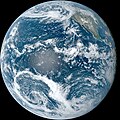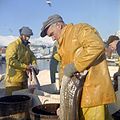The Oceans Portal
A portal dedicated to oceans, seas, oceanography and related topics
– Hover over image and scroll to middle for controls to see more selected panorama images –
Introduction
| Earth's ocean |
|---|
|
Main five oceans division: Further subdivision: Marginal seas |

The ocean is the body of salt water that covers approx. 70.8% of Earth. In English, the term ocean also refers to any of the large bodies of water into which the world ocean is conventionally divided. The following names describe five different areas of the ocean: Pacific, Atlantic, Indian, Antarctic/Southern, and Arctic. The ocean contains 97% of Earth's water and is the primary component of Earth's hydrosphere, thus the ocean is essential to life on Earth. The ocean influences climate and weather patterns, the carbon cycle, and the water cycle by acting as a huge heat reservoir. (Full article...)

A sea is a large body of salty water. There are particular seas and the sea. The sea commonly refers to the ocean, the wider body of seawater. Particular seas are either marginal seas, second-order sections of the oceanic sea (e.g. the Mediterranean Sea), or certain large, nearly landlocked bodies of water. (Full article...)
Oceanography (from Ancient Greek ὠκεανός (ōkeanós) 'ocean', and γραφή (graphḗ) 'writing'), also known as oceanology, sea science, ocean science, and marine science, is the scientific study of the oceans. It is an Earth science, which covers a wide range of topics, including ecosystem dynamics; ocean currents, waves, and geophysical fluid dynamics; plate tectonics and seabed geology; and fluxes of various chemical substances and physical properties within the ocean and across its boundaries. These diverse topics reflect multiple disciplines that oceanographers utilize to glean further knowledge of the world ocean, including astronomy, biology, chemistry, geography, geology, hydrology, meteorology and physics. Paleoceanography studies the history of the oceans in the geologic past. An oceanographer is a person who studies many matters concerned with oceans, including marine geology, physics, chemistry, and biology. (Full article...)
Selected article -

Cruise ships are large passenger ships used mainly for vacationing. Unlike ocean liners, they typically embark on round-trip voyages to various ports of call, where passengers may go on tours known as "shore excursions". They may carry thousands of passengers in a single trip, and are some of the largest ships in the world by gross tonnage (GT), bigger than many cargo ships. Cruise ships started to exceed ocean liners in size and capacity in the mid-1990s; before then, few were more than 50,000 GT. In the decades since the size of the largest vessels has more than doubled. There have been nine or more new cruise ships added every year since 2001, most of which are 100,000 GT or greater. In the two decades between 1988 and 2009, the largest cruise ships grew a third longer (268 m to 360 m), almost doubled their widths (32.2 m to 60.5 m), doubled the total passengers (2,744 to 5,400), and tripled in volume (73,000 GT to 225,000 GT). , the largest cruise ship, Icon of the Seas, has a gross tonnage of 248,336, is 365 metres (1,198 ft) long and holds up to 7,600 passengers.
Cruise ships are organized much like floating hotels, with a complete hospitality staff in addition to the usual ship's crew. They cater to nautical tourists, with recent vessels being described as "balcony-laden floating condominiums". The "megaships" went from a single deck with verandas to all decks with verandas, and feature ameneties such as theaters, fine-dining and chain restaurants, spas, fitness centers, casinos, sports facilities, and even amusement park attractions. (Full article...)Interesting facts -
- Nearly 350,000 metric tons of Pacific ocean perch (pictured) were caught in the Gulf of Alaska by Soviet and Japanese trawling fleets in 1965.
- Photos of the rogue wave encountered by the MS Stolt Surf contributed to the growing evidence of their presence in the deep ocean.
- Frances has tied Arlene (at eight times) as the most-used name for tropical cyclones in the Atlantic Ocean.
Selected list articles and Marine habitat topics
| Marine habitats |
|---|
| Coastal habitats |
| Ocean surface |
| Open ocean |
| Sea floor |
- List of oceans
- List of ancient oceans
- List of seas
- List of circumnavigations
- List of cruise lines
- List of largest lakes and seas in the Solar System
- List of marine biologists
- List of marine ecoregions
- List of maritime explorers
- List of naval battles
- List of ocean liners
- List of oceanographic institutions and programs
- List of oldest surviving ships
- List of rogue waves
- List of seafood dishes
- List of submarine topographical features
Tasks
 |
Here are some tasks awaiting attention:
|
General images -
Related portals
In the news
- 14 June 2024 – Red Sea crisis
- The United States military launches attacks on and destroys 7 Houthi radar stations in Yemen in retaliation after a merchant sailor went missing following Houthi strikes on ships in the Red Sea. (The Seattle Times)
- 13 June 2024 –
- A Russian warship and a nuclear-powered submarine conduct military drills in the Caribbean sea simulating a missile strike on enemy ships after passing near the coast of Florida in order to reach Havana, Cuba. (AP)
- 12 June 2024 – Red Sea crisis
- The Houthis strike and sink the Greek-owned, Liberian-flagged cargo ship Tutor with an unmanned surface vehicle. (Reuters)
- 8 June 2024 –
- Doctors Without Borders recovers 11 bodies and rescues dozens of migrants off the coast of Libya. (Al Jazeera)
- 7 June 2024 – Yemeni civil war
- Red Sea crisis
WikiProjects
Topics
Categories
Associated Wikimedia
The following Wikimedia Foundation sister projects provide more on this subject:
-
Commons
Free media repository -
Wikibooks
Free textbooks and manuals -
Wikidata
Free knowledge base -
Wikinews
Free-content news -
Wikiquote
Collection of quotations -
Wikisource
Free-content library -
Wikiversity
Free learning tools -
Wiktionary
Dictionary and thesaurus
Admiralty law
| Admiralty law |
|---|
| History |
| Features |
| Contract of carriage/Charterparty |
| Parties |
| Judiciaries |
| International conventions |
| International organizations |
Need assistance?

Do you have a question about oceans, seas or oceanography that you can't find the answer to? Consider asking it at the Wikipedia reference desk.
External media

- World Ocean Database and World Ocean Atlas Series – from the U.S. National Centers for Environmental Information, National Oceanic and Atmospheric Administration. Includes the World Ocean Atlas.
- European Atlas of the Seas – the European Atlas of the Seas, from the European Commission
- NOAA Research – NOAA research news, Oceanic and Atmospheric Research (OAR)
- Ocean Research – from The World Ocean Observatory
- Ocean Biodiversity Information System – "a global open-access data and information clearing-house on marine biodiversity for science, conservation and sustainable development"








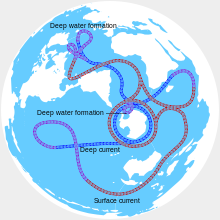



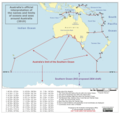
![Image 3"Terres Australes" [sic] label without any charted landmass (from Southern Ocean)](http://upload.wikimedia.org/wikipedia/commons/thumb/8/8e/Geography_world_map.jpeg/120px-Geography_world_map.jpeg)










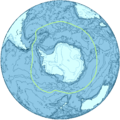





































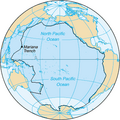

![Image 57An exclusive economic zone (EEZ) map of the Pacific which excludes non-tropical islands.[why?] (from Pacific Ocean)](http://upload.wikimedia.org/wikipedia/commons/thumb/b/bc/Map_of_the_Exclusive_Economic_Zones_of_the_Pacific_Ocean.png/120px-Map_of_the_Exclusive_Economic_Zones_of_the_Pacific_Ocean.png)



